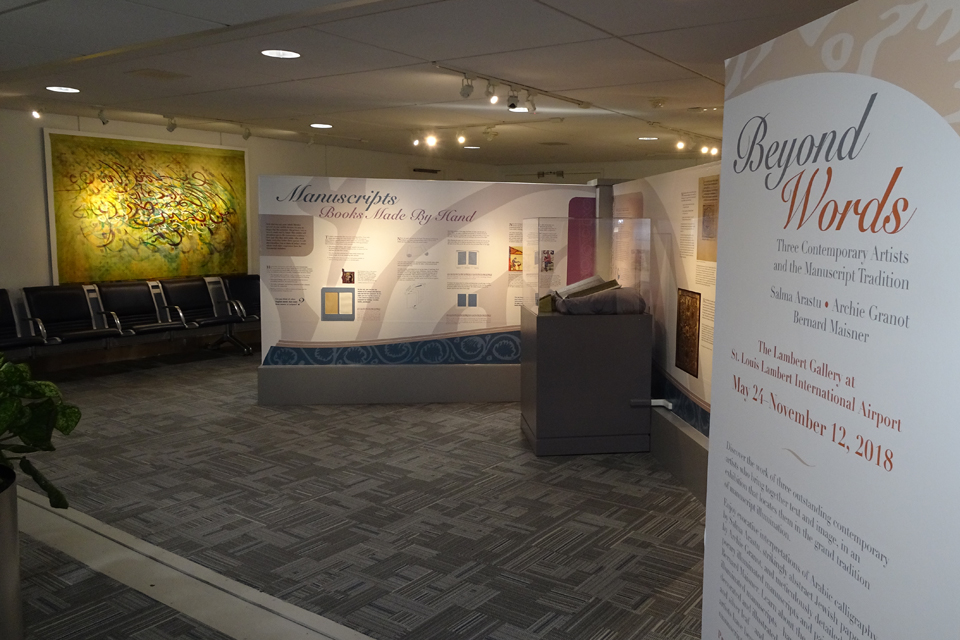Beyond Words: Three Contemporary Artists and the Manuscript Tradition
Three outstanding contemporary artists who bring together text and image in their work — Salma Arastu, Archie Granot and Bernard Maisner — are highlighted in an exhibition that locates them in the context of the grand tradition of manuscript illumination.
May 24 to November 12, 2018
The Lambert Gallery
St. Louis Lambert International Airport, Terminal 1
About the Exhibition
MOCRA, in collaboration with the Special Collections division of the Saint Louis University Libraries, presents a special exhibition in the Lambert Gallery at St. Louis Lambert International Airport as part of the Lambert Art and Culture Program. Beyond Words highlights the work of three outstanding contemporary artists — Salma Arastu, Archie Granot and Bernard Maisner — who bring together text and image in their work, and locates them in the context of the grand tradition of manuscript illumination.
Salma Arastu
The life journey of Salma Arastu has taken her from India to the Bay Area and from Hinduism to Islam. Arastu freely interprets classical Arabic calligraphy and manuscript illumination techniques in her work. The 2015 MOCRA exhibition Painting Prayers: The Calligraphic Art of Salma Arastu, included a number of large tapestry-like paintings on canvas that illuminate passages from the Qur’an, as well as works juxtaposing sacred texts from a variety of traditions. Examples of these works will be included in Beyond Words.
Archie Granot
Israeli artist Archie Granot was commissioned to execute a Haggadah (the book containing the texts of the Passover Seder meal), employing his unique approach to the venerable art of papercutting. Made up of over 50 individual works, each with a unique design, The Papercut Haggadah was displayed at MOCRA in 2012. Beyond Words includes examples of pages from The Papercut Haggadah, along with other commissioned papercut works.
Bernard Maisner
Bernard Maisner is considered one of today’s foremost calligraphers and an expert practitioner of the techniques of medieval manuscript illumination. He was the subject of two MOCRA exhibitions, Entrance to the Scriptorium in 1998–99, and The Hourglass and the Spiral in 2017. Maisner’s capacity for inventive compositions and his wide-ranging selections of texts (from Heraclitus to William Blake to Henry Miller to Soren Kierkegaard to Patti Smith) astound and delight viewers. Examples of Maisner’s manuscripts and paintings will be included in Beyond Words.
The Manuscript Tradition
Beyond Words brings together the work of these three artists with the long tradition of illuminated manuscripts – handwritten books richly decorated and illustrated with paints, inks, and gold and silver leaf. The exhibition will give an introduction to the techniques of making parchment from animal skins, assembling books by hand, and writing and illuminating the texts. Examples of lavishly illuminated historic manuscripts will be compared with the works of Arastu, Granot, and Maisner, showing how these contemporary artists have been influenced by and extend the manuscript tradition. In particular, five facsimiles (highly detailed reproductions) of famous illuminated manuscripts, including the Book of Kells and the Rothschild Miscellany, will be displayed.
While Beyond Words focuses primarily on the aesthetic and historical dimensions of these works, an interfaith dimension is present as well. The historical examples will include manuscripts from the Jewish, Christian and Muslim traditions, including a discussion of the development of Arabic calligraphy and its connection to Islam. Both Arastu and Granot create works that express their faith traditions, while Maisner explores a wide swath of spiritual and philosophical perspectives.
Beyond Words will provide an opportunity for viewers to make connections to their own experiences of faith and spirituality, and to reflect on the challenges facing all of us as we learn to appreciate the diversity of beliefs and cultures that are found across the globe and in our region.
